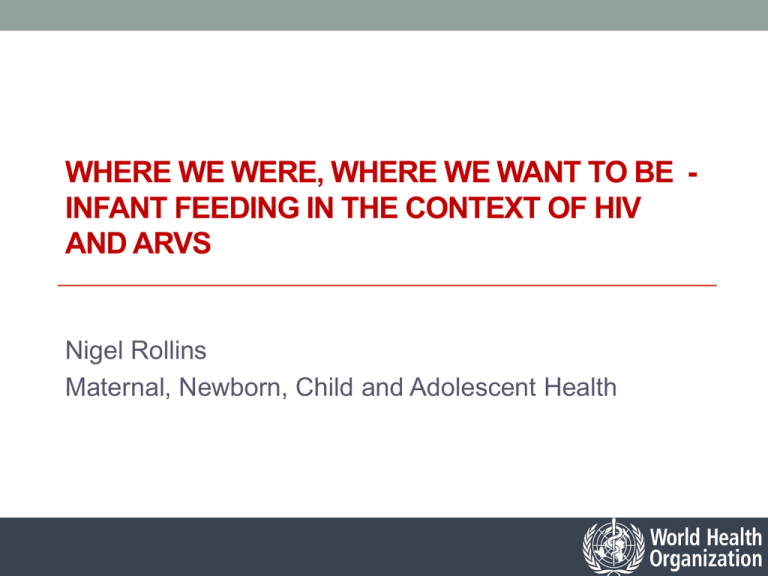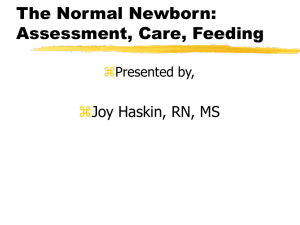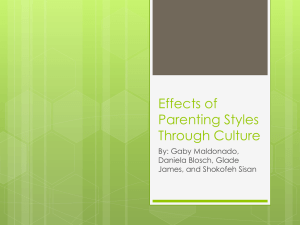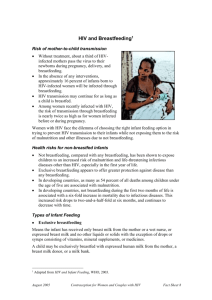Powerpoint - AIDS 2014 - Programme-at-a
advertisement

WHERE WE WERE, WHERE WE WANT TO BE INFANT FEEDING IN THE CONTEXT OF HIV AND ARVS Nigel Rollins Maternal, Newborn, Child and Adolescent Health WHO recommendations on HIV and infant feeding 2000 • When replacement feeding is acceptable, feasible, affordable, sustainable and safe, avoidance of all breastfeeding by HIV-infected mothers is recommended • Otherwise, exclusive breastfeeding is recommended during the first months of life 2006 • The most appropriate infant feeding option for an HIV-infected mother should continue to depend on her individual circumstances, including her health status and the local situation, but should take greater consideration of the health services available and the counselling and support she is likely to receive. • Exclusive breastfeeding is recommended for HIV-infected women for the first 6 months of life unless replacement feeding is acceptable, feasible, affordable, sustainable and safe for them and their infants before that time • HIV-infected women should be given ‘specific guidance in selecting the option most likely to be suitable for their situation’ i.e. promote informed and free choice of infant feeding methods for HIV-infected mothers Assumes accuracy of information and that women can enforce their ‘choice’ Does a recommendation endorsing breastfeeding to an HIV-infected mother in Africa, represent duplicity in ethical standards? December 5th 2000 Wyeth, Nestle Offer Free Tins to Stem Spread of AIDS "After years of being hated by advocates of breast-feeding, Nestlé and the rest of the baby food industry must have wept with delight at articles in the Wall Street Journal last December (2000). The Wall Street Journal …… painted the baby food manufacturers as heroes poised to save African children from certain death." "HIV – will it be the death of breastfeeding?" 23,998 cases of infant diarrhoea and 486 deaths. Mainly amongst infants in PMTCT programmes Creek T, 2006 Mortality in FF vs. BF infants (excl. infants weaned before 12m) HR 6.3 (95%CI = 1.4-28.0, p=0.02) In the absence of ARVs interventions, HIV free survival of uninfected infants who were BF or FF @12 m was equivalent. Number of respondents Myth: 100% of infants born to HIV-infected mothers who breastfeed will become infected 160 140 120 100 80 Response to question: If 100 HIV-infected women breastfeed until their children are two years old how many children will be infected at 2 years of age? (mother and child do not receive any antiretroviral medicines) 60 40 20 0 0 - 20 20 - 40 40 - 60 60 - 80 80 - 100 Don't Know Number of infants infected Chopra and Rollins, Arch. Dis. Child. 2008 Feeding at some PMTCT sites 100 90 80 70 60 50 40 30 20 10 0 BF FF Rietvlei ZeerustShongwe COSH Rural Rural Rural Rural Durban Pmb Urban Urban The quality of infant feeding counselling translated into HIV free survival of infants Woldenbeset. IAS 2009 Then … Breastfeeding, Antiretroviral and Nutrition (BAN) study (Chasela, IAS 2009) 3 Arms: Control Mothers receive lopinavir/ritonavir for 28 wks throughout BF period Breastfeeding infants received daily NVP for 6 months Infant HIV transmission and mortality rates % 10.0 9.0 Control 8.0 7.0 6.0 5.0 7.6% 6.4% p=0.003 4.0 3.0 2.0 1.0 0.0 Maternal LPV/r for 6 mo Inf NVP for 6 mo 4.7% 3% 2.9% 1.8% p=0.001 Transmission at 6 mo Death at 6 mo •NVP to infants for 14 wks 0.20 0.15 0.00 •NVP and AZT to infants for 14wks Control Extended NVP Extended NVP+ZDV 0.10 •Control 0.05 3 arms: Probability of HIV-1 Infection 0.25 0.30 Probability of HIV-1 Infection in Infants Uninfected at Birth by Treatment Arm: PEPI-Malawi 1wk 9wk 6mo 9mo 12mo 15mo 18mo 24mo Infant Age Age 1 wk 6 wks 9 wks 14 wks 6 mos 9 mos 10.6 5.2 6.4 12 mos 15 mos 18 mos 24 mos Estimates (%) Control 0.3 5.1 7.4 8.4 10.1 Extended NVP 0.1 1.7 2.6 2.8 4.0 Extended NVP+ZDV 0.2 1.6 2.4 2.8 5.2 11.5 12.4 13.9 14.5 7.0 7.8 10.1 11.2 8.1 8.7 10.2 12.3 Mma bana study (Shapiro, IAS 2009) Infant HIV transmission % 2 randomised arms and one observational Mothers not eligible for ART received either: lopinavir/ritonavir and combivir } for 6m or abacavir/AZT/3TC } while BF Mothers eligible for ART – outcomes observed 10 9 8 7 6 5 4 3 2 1 0 Viral suppression >92% all groups LPV/r + combivir Abacavir/AZT/3TC Observational Mothers not eligible for ART Observational Infant HIV-free survival rates to 12 months of age.RCT, by study stratum 2 arms - AZT + 3TC + LPV/r until •Delivery only (Short) then nil Or 0.95 0.90 Short Triple 0.75 •End of BF ~6mths (Triple) 0.85 RCT in Kenya, Burk. Faso and SA 0.80 Proportion alive and not infected 1.00 Kesho Bora: All infants: HIV-free survival Log rank test p = 0.022 (stratified on centre and intention to BF) 0 1 2 3 4 5 6 7 8 9 10 Age (in months) Triple Short Events (cum) / at risk Rate (95% CI) Events (cum) / at risk Rate (95% CI) Reduc -tion Birth 11/400 2.7 (1.5, 4.9) 11/403 2.7 (1.5, 4.9) 0% 6 weeks 19/377 4.8 (3.1, 7.4) 24/376 6.0 (4.1, 8.8) 20 % 6 months 33/347 8.3 (6.0, 11.5) 50/334 12.6 (9.7, 16.3) 34 % 12 months 40/278 10.4 (7.7, 13.9) 62/252 16.3 (12.9, 20.5) 36 % 11 12 WHO guidelines http://www.who.int/hiv/en/ Setting national recommendations for infant feeding in the context of HIV National (or sub-national) health authorities should decide whether health services will principally counsel and support mothers known to be HIV-infected to: - breastfeed and receive ARV interventions, or, - avoid all breastfeeding, as the strategy that will most likely give infants the greatest chance of HIV-free survival. This decision should be based on international recommendations and consideration of the socio-economic and cultural contexts of the populations served by Maternal and Child Health services, the availability and quality of health services, the local epidemiology including HIV prevalence among pregnant women and main causes of infant and child mortality and maternal and child under-nutrition 22 UNAIDS priority countries (2012) • The vast majority have adopted Breastfeeding with ARVs as policy • Still low/uncertain coverage of ARVs among BF mothers • Poor quality data Local adaptation and implications Individualizing the WHO HIV and infant feeding guidelines: optimal breastfeeding duration to maximize infant HIV-free survival. CiarenelloAL. AIDS 2014. Jul 28. Suppl 3:S287-99 • An individualized approach leads to moderate gains in HFS, but only when mortality risks from replacement feeding are very low or very high, or antiretroviral drug availability is limited. The WHO public health approach is beneficial in most resource-limited settings. Malawi – option B+ Breastfeed – 24 months ? Botswana – IMR 41 CMR 53 2012 Int J Health Plann Manage. 2013 Jul-Sep;28(3):257-68 'Findings suggest that WHO Guidelines on preventing vertical transmission of HIV through exclusive breastfeeding in resource-limited settings are not being translated into action by governments and front-line workers because of a variety of structural and ideological barriers.' Mma bana study 2 randomised arms and one observational Mothers not eligible for ART received either: lopinavir/ritonavir and combivir } for 6m or abacavir/AZT/3TC } while BF Mothers eligible for ART – outcomes observed Infant HIV transmission % 10 9 8 7 6 5 4 3 2 1 0 Mothers not eligible for Observational ART 1248 pregnant women referred to study sites. After counselling about study interventions, 110 (8.8%) declined enrolment as preferred to give formula feeds. Where we want to be • Where HIV-infected mothers do not need to think about their status when they feed their infants. • Zero risk of HIV transmission • HIV-infected mothers have confidence in the benefits of BF • Health workers have confidence to promote and support BF • Breastfeeding does not have any negative connotation • Where HIV investment to promote and support breastfeeding among HIV-infected mothers, can also support breastfeeding among the general population and vice versa • Where HIV-infected mothers and their infants can benefit from all social and health aspects of breastfeeding • Where HIV-free survival and development is the metric of success Research questions • Approaches for reducing the residual risk of HIV transmission • Confirm minimal risk of low dose ARVs to BF infants • Implementation research questions • How to track ARV coverage among HIV-infected mothers who are breastfeeding – for surveillance and improving programmes • How to optimally support HIV-infected mother while BF - Health workers issues / community issues Revision process of WHO guidelines on HIV and Infant Feeding • Last recommendations 2010 • Planning for guideline review mid-2015 • To review experiences and new evidence since last guidelines • What have been the experiences regarding implementation of the 2010 guidelines on HIV and IF • Areas where there is new research • What are the main issues/challenges related to implementation of guidelines e.g. 'How long to BF' • Aspects that need to be examined or need better articulation • Issues related to specific regions or population Acknowledgements • Tin Tin Sint. UNICEF • Carmen Casanovas. WHO ______________________________________________ • Design and implementation challenges for PMTCT implementation research. The INSPIRE Initiative: A South-South collaboration • Tuesday 22 July. 18.30-20.30 • Plenary 3




